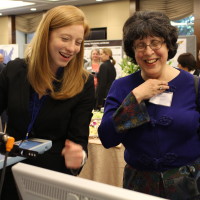CCC Community Report for a National Privacy Research Strategy
In April, the Computing Community Consortium (CCC) commissioned members of the privacy research community to generate a short report to help guide strategic thinking in this space. The effort aimed to complement and synthesize other recent documents, including the White House BIG DATA: Seizing Opportunities, Preserving Values Report and the Report to the President on Big Data and Privacy: A Technological Perspective.
Today, the CCC is releasing the resultant community report, Towards a Privacy Research Roadmap for the Computing Community:
Great advances in computing and communication technology are bringing many benefits to society, with transformative changes and financial opportunities being created in health care, transportation, education, law enforcement, national security, commerce, and social interactions. Many of these benefits, however, involve the use of sensitive personal data, and thereby raise concerns about privacy. Failure to address these concerns can lead to a loss of trust in the private and public institutions that handle personal data, and can stifle the independent thought and expression that is needed for our democracy to flourish.
This report, sponsored by the Computing Community Consortium (CCC), suggests a roadmap for privacy research over the next decade, aimed at enabling society to appropriately control threats to privacy while enjoying the benefits of information technology and data science. We hope that it will be useful to the agencies of the Federal Networking and Information Technology Research and Development (NITRD) Program as they develop a joint National Privacy Research Strategy over the coming months. The report synthesizes input drawn from the privacy and computing communities submitted to both the CCC and NITRD, as well as past reports on the topic.
Privacy is a broad topic, encompassing a variety of issues in many different contexts. Our focus is on concerns raised by the collection, sharing, analysis, and use of personal data in information systems. Even with this bounded scope, the privacy concerns in consideration are manifold, including (but not limited to) unwanted disclosure of personal information, lack of transparency and control around how one’s information is used, and discrimination based on personal information…
The editors of the paper go on to describe a research agenda that seeks to lead the community to a state where:
- We have a rigorous science of privacy that applies across different application domains;
- We understand the needs, expectations, and incentives of the humans who use information systems, and can design systems that are sensitive to them;
- Privacy technology research and privacy policy objectives are informed by and aligned with each other; and
- We can engineer systems that enable us to enjoy both privacy and the benefits of data use to the maximum extent possible, showing that the tradeoff between the two can be much less stark than our current approaches offer:
To reach this state, the editors believe that the research strategy needs to:
- Emphasize understanding, defining, and measuring the privacy of information systems;
- Recognize and support the many stages and dimensions of privacy research;
- Enable interdisciplinary research strategies; and
- Foster a technology-policy dialogue
The report was presented to the NITRD Privacy Research and Development Working Group on Friday, May 9.
We encourage everyone to read the report and view the presentation.
And on behalf of the CCC, we thank our colleagues in the privacy research community for providing a clear, thoughtful, and compelling report in very short order! (The names of all the contributors appear on the final page of the report.) Special kudos to Tal Rabin of IBM Research and Salil Vadhan of Harvard University, for their extraordinary job chairing this effort and to Lorrie Cranor of Carnegie Mellon University, Vitaly Shmatikov of University of Texas at Austin, and Danny Weitzner of Massachusetts Institute of Technology for their time and effort in writing this report.









